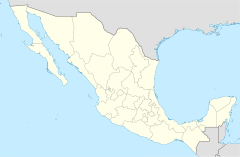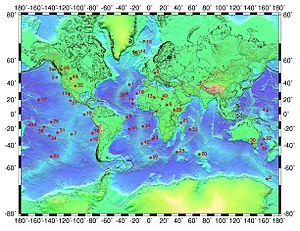Socorro Island facts for kids
|
Native name:
Isla Socorro
|
|
|---|---|
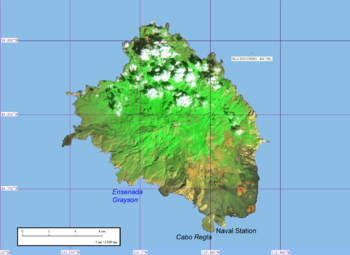
Socorro Island, from satellite image
|
|
 |
|
| Geography | |
| Location | Pacific Ocean |
| Coordinates | 18°47′04″N 110°58′30″W / 18.78444°N 110.97500°W |
| Archipelago | Revillagigedo Islands |
| Area | 132 km2 (51 sq mi) |
| Length | 16.5 km (10.25 mi) |
| Width | 11.5 km (7.15 mi) |
| Highest elevation | 1,150 m (3,770 ft) |
| Highest point | Mount (Cerro) Evermann |
| Administration | |
| Demographics | |
| Population | 250 |
| Pop. density | 0.34 /km2 (0.88 /sq mi) |
Socorro Island (which means Isla Socorro in Spanish) is a volcanic island. It is part of the Revillagigedo Islands, which belong to Mexico. The island is about 600 kilometers (370 miles) off Mexico's western coast.
Socorro Island is about 16.5 kilometers (10.25 miles) long and 11.5 kilometers (7.15 miles) wide. Its total area is about 132 square kilometers (51 square miles). It is the biggest of the four islands in the Revillagigedo group. The volcano on Socorro Island last erupted in 1993.
Contents
Island Geology: A Volcanic Wonder
Socorro Island rises sharply from the ocean. Its highest point is 1,050 meters (3,440 feet) above sea level. The island is actually the top of a huge underwater shield volcano.
The volcano on Socorro Island has erupted several times. The most recent eruption was in early 1993. This eruption happened underwater near Punta Tosca. Before that, eruptions likely occurred in 1951, 1905, 1896, and 1848. Scientists believe the first volcanic event happened around 3090 BC.
The highest point on the island is called Mount Evermann (Cerro Evermann in Spanish). It was named after a fish expert, Barton Warren Evermann. The island's surface has many cracks, small craters, and deep valleys. It is covered with different types of lava formations.
A naval station was built on the island in 1957. About 250 people, including staff and their families, live there. They have a village with a church. The station is on the western side of Bahia Vargas Lozano, a small bay with a rocky beach. The station has a dock, a helipad, and a small airport. There is also a spring that provides fresh water, but it can be a bit salty.
Island History: Discoveries and Visitors
No one lived on Socorro Island before it was discovered. A Spanish explorer named Hernando de Grijalva and his crew found it on December 19, 1533. They first called it Santo Tomás (St Thomas Island).
In 1542, Ruy López de Villalobos rediscovered the island. He renamed it Isla Anublada (Cloudy Island). This was because clouds often formed on the northern slopes of Mount Evermann. Later, in 1608, Martín Yañez de Armida visited the island. He changed its name to Isla Socorro, honoring Our Lady of Perpetual Help.
In the early 1900s, Barton Warren Evermann, who was the director of the California Academy of Sciences, encouraged scientists to explore the island. Many important collections of plants and animals were gathered then. The volcano was later named Mount Evermann in his honor.
An American worker named Archie Smith was stranded on the island in 1929. He was there to shear wild sheep. His expedition left for supplies but went bankrupt and couldn't return. He was rescued after one month by a fishing boat.
In September 1997, Hurricane Linda passed close to the island. It caused only minor damage to the weather equipment there.
Island Ecology: Unique Plants and Animals
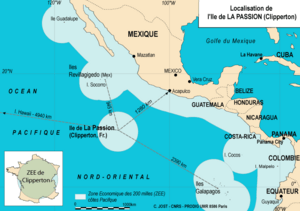
The lower parts of Socorro Island are covered with thick shrubs. These include a plant called Croton masonii and a type of cactus. Higher up and on the northern side, there are more kinds of plants. These include small trees like Ficus cotinifolia and black cherry trees. You can also find orchids growing on these trees.
The island's native land animals are mostly birds. There are no native mammals. There is one unique type of lizard (Urosaurus auriculatus). A type of land crab also lives here.
Over time, humans brought sheep, cats, and rodents to the island. More recently, a type of locust has also arrived. The sheep and rodents did not cause much harm to the plants. However, the cats have had a big impact on the birds since the 1970s. This is because the native birds were not afraid of predators. The locusts also damage plants when they swarm twice a year.
No plants are known to have disappeared from Socorro Island. But several bird species have been greatly affected by the cats. Sadly, the Socorro dove is now extinct in the wild.
Socorro Island is an important place for many seabirds to breed. Many of these birds have their northernmost breeding colonies here. Scientists are still studying how these birds are doing now. They have likely suffered from the cats.
Some of the seabirds that breed or visit here include:
- Wedge-tailed shearwater
- Western red-billed tropicbird
- Nazca booby
- Northeast Pacific brown booby
- East Pacific great frigatebird
- East Pacific sooty tern
- East Pacific brown noddy
Other land birds and shorebirds often visit the island during migration. The northern mockingbird settled on the island in the late 1900s. Birds like the great blue heron and spotted sandpiper are also seen often.
Endemic Species: Animals Found Only Here
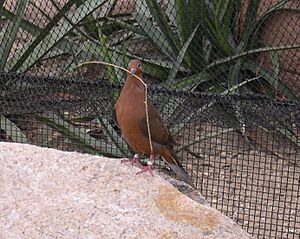
Socorro Island is home to many unique animals and plants. These are called endemic species, meaning they are found nowhere else in the world. Some of these species are now in danger because of the wild cats on the island.
Here are some of the animals found only on Socorro Island:
- Socorro parakeet (in danger)
- Socorro red-tailed hawk
- Socorro common ground dove
- Socorro elf owl (likely extinct since about 1970)
- Socorro mockingbird (very critically in danger)
- Socorro yellow-crowned night heron
- Socorro tropical parula
- Socorro towhee
- Townsend's shearwater (very critically in danger)
- Socorro wren (near danger)
- Socorro dove (extinct in the wild, only lives in zoos)
- Urosaurus auriculatus (in danger)
Endemic Species: Plants Found Only Here
Many unique plants also grow only on Socorro Island. Here is a list of some of them:
- Acalypha umbrosa
- Aegopogon solisii
- Aristida vaginata
- Aristolochia socorroensis
- Bidens socorrensis
- Botrychium socorrense
- Castilleja socorrensis
- Cestrum pacificum
- Coreocarpus insularis
- Croton masonii
- Erigeron socorrensis
- Eupatorium pacificum
- Guettarda insularis
- Hypericum eastwoodianum
- Ilex socorroensis
- Lantana involucrata var. socorrensis
- Lepechinia hastata ssp. socorrensis
- Meliosma nesites
- Paspalum longum
- Peperomia socorronis
- Physalis mimulus
- Pleurothallis unguicallosa
- Salvia pseudomisella
- Sida nesogena
- Sideroxylon socorrense (in danger)
- Verbena sphaerocarpa
- Vernonia littoralis
Some other plants are almost endemic. This means they are found on Socorro and also on nearby Clarion Island.
Visiting Socorro Island: Scuba Diving Adventures
Socorro Island is a very popular place for scuba diving. Divers love to visit because they can see dolphins, sharks, manta rays, and other large ocean animals up close.
There is no public airport on the island. So, divers usually visit by staying on special dive boats. The best time to visit is between November and May. During these months, the weather and ocean are usually calm.
From November to December, divers have a good chance to swim with whale sharks. In January and February, it's a great time to see humpback whales. They migrate through the Revillagigedo islands during these months.
See also
 In Spanish: Isla Socorro para niños
In Spanish: Isla Socorro para niños
- List of volcanoes in Mexico


